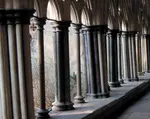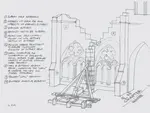Supervisor: Prof. Dr.-Ing. Stefan Breitling
Coordinator: Dr. Zeynep Aygen, Mike Underwood, Sarah Lupton, James Gordon
Participants: Andy Bradley, John Campbell, Furgac Levent, Kate Mackay, Annie Martin, Caroline Rye, Peter Webberley, Anne Geller
As already in the previous years also 2009 the cloisters of Salisbury Cathedral became object of study to students of the MSc Historic Building Conservation Course at the University of Portsmouth. Accompanying the restoration of the cathedral, the researches, provided by Mr. Edds, Head of Buildings and Estates in cooperation with the Otto-Friedrich-Universität Bamberg, this time dealt with the architectural history of the east wing of the cloister with focus on the southeast exterior wall of the cloister, the tracery of bay 19 and the constructive characteristics of the two-storey bays of the northern part of the east wing.
Analysis of the southeast exterior wall
The east wing is said to be the first part of the cloisters being built in the middle of the 13th century. Especially the south-western entrance of the transept of the cathedral and the access to the famous chapter house give important determinations for the geometric layout of the cloister. Its north wing focuses on the door of the transept; bay 17 is centred on the axis of the chapter house. It is obvious, that there was no exact plan of the cloister when the chapter house was erected, because the module of the bays doesn’t fit, and it was therefore necessary to condense the last bay to the north wing.
Knowing this, it was interesting to read from the masonry of the exterior wall of the east wing how it has originally been built. A photogrammetric survey helped to record the directions and phases in which the stones where put in place (fig. 3). A further analysis of the building method was carried out using the tachymeter to show the courses that ran through several bays together with the irregularities in the outline of the wall. This plan was placed on top of photographs taken of the bays to gain a better understanding of the building process. The drawing was then overlaid with directional arrows and joints that indicate the direction the cloister wall was built.
Unsurprisingly the directions correspond with the scaffolding holes. Occasionally the masons would build up a buttress and fill in the courses to match. There is a levelling course at about one meter underneath the first set of scaffolding marks, another at the springing of the attic in about five meters from the ground which continues throughout the whole length of the wall. An in-depth look at the stones at the corners between the chapter house, passageway and cloister wall indicate that the construction of all three were around the same time and were laid out together until the height of about one meter. The corner between the passage and the cloister has more continuous courses, the chapter house buttress connects to the passageway and it appears as though some of the courses were chiselled in situ to allow for the tracery windows in the corridor.
The five vaults in the cloister bays 16 to 20 correspond to buttresses on the exterior wall except where the last buttress would be expected. This missing buttress together with a scarf in the wall had led to the reconstruction of two separate building phases. But also in the leftmost bay with the passageway one can see continuous courses. Also the scaffolding holes correspond left and right from this interruption and the position of the stones on both sides makes it difficult to believe in a former corner in this area. The outline shows that there was an older wall running eastwards, when the masons erected the cloister. Because of the wall they could spare the buttress in this place.
Analysis of the tracery of bay 19
Detailed investigation of the tracery of the inner wall of bay 19 may reveal the construction methods utilised by the medieval builders´ responsible (fig. 2). 30 different masonry elements in total could have been identified. From this the most likely phasing of its construction can be deduced.
The large rose window section may be the consistent feature; a pre defined radius that was the key element of proportion within the cloister construction with selected stones tailored to the space. As indicated on the drawing the radius of the large rose dictated the radius of the secondary arches. The likeliest construction sequence may have been as illustrated on the drawing (fig 2). Temporary supports are likely to have been placed at element 16/17 with elements 18 & 19 tailored to complete the circle at the end of the 2nd phase of construction; the supports would then be removed once the apex voussiers (elements 24/25) were positioned. Fillets suggest that errors were made in the masonry elements manufactured; these fillets run through the profile, internal to external, which may confirm that they are not repaired sections. A deeper recess to the moulding on the masonry profile and the existence of iron framing confirms the deliberate insertion of glazed tracery.
Viewing other bays it is clear that every bay was tailored individually to the width between the buttress constructions. A slight difference in stone sizes is apparent although the number of elements is consistent with the exception of bay 19. Bay 19 is the widest within the east wing and consists of an extra element (28 as opposed to 27 in the remaining bays including bay 11, the narrowest within the cloister). Viewed externally the quatrefoil to the left differs not only from its counterpart but from all remaining bays, excluding the narrow bay number 3 which has trefoils. This squashed arch or horseshoe shape could be explained by a later addition or a special symbolic meaning.
Analysis of the inner buttresses
The inner wall of the east cloister differs significantly from the construction of the other three wings, notably there are a series of relieving arches set 60-70 cm above the tracery arches of each bay (fig. 2). In addition the buttresses are stronger, and a wedge-shaped block cut out from the front face of each buttress. Just under half of the eastern section of the cloister bears an upper storey containing the cathedral library. There is a differing though significant amount of deviation from the vertical in parts of the face work and buttresses (fig. 1). The base sections of all the buttresses along the east wall are vertical, yet sections above the weather offset together with the main sets of inner columns lean outward for six or seven courses. Below the relieving arch the wall leans outward, like the tracery beneath, whilst above it returns to vertical. The positions of the holes cut in the buttresses roughly correspond with this change from the vertical.
This evidence can only be explained if one suggests that at a given time after the construction of the original cloister the inner east wall was partly taken down, along with parts of the buttress, and rebuilt in order to correct leaning in parts of the masonry. Surly this was done in preparation for the additional weight of the library. Obviously it had been planned to transform the whole east wing into a two-storey building, for the reinforcements had been carried out for all of its bays.
This theory is further supported by the stonework of the lower portions. Here it is possible to identify where the later stonework was cut into the back of the original buttress indicated by differing and wider mortar bed sizes, irregular block bonding patterns and the remains of wedges used where new blocks have been stitched in. Likewise one can see on the ashlars face of the wall above the tracery arch that the lean on the original stonework has been corrected after the insertion of the relieving arch that should protect the tracery below.
From this the process of the “restoration” can be deduced (fig. 4). The holes in the buttresses had been used to house props inserted to support the outward thrust from the vaulting during building work to extend and thus strengthen the base of the buttresses. It would seem likely that at the same time the buttresses were strengthen that this face wall was taken down to allow the insertion of the relieving arch which explains the improved verticality of all stonework above this point.
IV/2009




